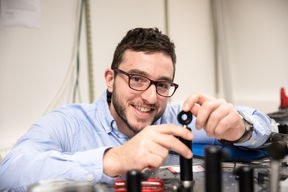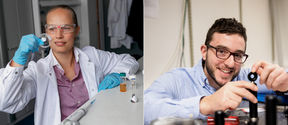EU grants for smart materials and next generation LEDs
Three million euros grants to Assistant Professor Jaana Vapaavuori and Postdoctoral Researcher Konstantinos Daskalakis to make environmentally friendly materials

Lighting consumes one-fifth of the world's electrical energy and it produces a total of 400 million tonnes of carbon dioxide emissions per year. This means that lighting accounts for 1.2% of all emissions.
Efforts to make lighting more efficient have led to the development of light-emitting diodes (LEDs) that emit intense light when a small amount of electric current passes through them. LED lights are made of highly pure, crystalline inorganic semiconductors which consume a lot of energy to make.
‘LED lights are effective to use. The problems with LED lights are related to the adverse environmental effects following the production and use of the materials. On the contrary, the manufacture of the organic or carbon-based white OLED (WOLED) lights is more environmentally friendly, compared with traditional LED lights. However, current WOLED technologies still use rare earth and toxic heavy metal traces. I plan to develop truly ecological and easy-to-manufacture WOLEDs that can be also safely disposed of after use’, says Postdoctoral Researcher Konstantinos Daskalakis, who has just received EUR 1.5 million in funding for his project from the European Research Council (ERC). The project will run for five years.
Organic LEDs (OLEDs) work on the same principle as LEDs but are made of carbon-based semiconductors. They are already used in television and phone screens. The new devices being developed for the project are called WOLED lights when made to emit bright white light and used in lighting.
Existing WOLED light solutions are costly and inefficient. Expensive and non-renewable rare earth and toxic heavy metal traces are often used, and the manufacturing processes are difficult.
‘It is important to significantly reduce the price of WOLED lights while doubling their lighting efficiency and life cycle. Our innovation is based on quantum mechanics and photonics, and, in particular, the polariton states, which are hybrid states combining both the properties of material and light.’
The polariton states give new properties in materials allowing them to be manipulated with light so that the same material radiates and absorbs several colours in a controlled manner. In other words, polariton states could be used to modify a single material to emit multiple colours that are perceptible to the human eye as white colour.
‘We can create polariton states by encapsulating our OLED materials within nanometer spaced mirrors that help to trap light in the microscale. In this structure, light is emitted and absorbed simultaneously, making polaritons being indistinguishable from “just matter” or “just light”. In other words, we can control polaritons to emit light of many colours by carefully designing this microstructure.’
‘My core competence areas are photonics and light-emitting materials, and I use my expertise to address the challenges of WOLED lights. Through experimental research, I aim to demonstrate that polariton states enable the transition from traditional LED lights to affordable, efficient, stable, and bright OLED lights which emit white light.’
Further information:

Three million euros grants to Assistant Professor Jaana Vapaavuori and Postdoctoral Researcher Konstantinos Daskalakis to make environmentally friendly materials



